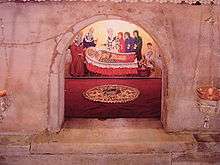Translation of the Relics of Saint Nicholas from Myra to Bari

The tomb of Saint Nicholas in Bari, as it appears today.
The Translation of the Relics of Saint Nicholas from Myra to Bari is a religious and folk holiday among the East Slavs and, to a lesser extent, the South Slavs, and Eastern Romance peoples. It celebrated on May 9 each year.[1][2] For (Old) Old (Julian) calendar churches, May 9 falls on May 22 of the New (Gregorian) calendar. The feast commemorates the translation (movement) of the relics Saint Nicholas from Myra, from present-day Turkey to Bari, on the Italian Peninsula to save them from the Turks who were persecuting Christians and destroying churches and holy objects. To this day the relics remain at the Basilica of Saint Nicholas. [note 1]
See also
- Nikoljdan, December 6
References
- ↑ Агапкина Т. А. Никола вешний // Славянские древности. Этнолингвистический словарь. Т. 3. — Москва: Институт славяноведения РАН, 2004, 704 с. — С. 394 – ISBN 5-7133-1207-0.
- ↑ Translation of the relics of St Nicholas the Wonderworker from Myra to Bari. OCA – Feasts and Saints.
- ↑ "St Nicholas "the Warm" (“teplij Mykola”) is a church-wide celebration in Ukraine. The Ukrainian Church was, at one time, the only Eastern Church that marked this day. Three festal days are, in fact, celebrated in St Nicholas’ honour in Ukraine: 1) December 6/19 (“Cold Nicholas”), together with the miracle of St Nicholas at the First Ecumenical Council; 2) May 9/22 (translation of his relics); and 3) the nativity of St Nicholas on July 29/August 10. There are several miraculous icons of St Nicholas in Ukraine, especially that of St Nicholas the Drenched of St Sophia Cathedral – now kept somewhere in New York City, according to some accounts. St Nicholas is a patron against drowning and any icon of St Nicholas saving people from drowning or where his icon has a small boat placed near it is called “St Nicholas the Drenched.” This title is taken from a miraculous recovery of a child presumed drowned in the Dnipro River where the child was found sleeping on the altar before the icon of St Nicholas, both of which were drenched with water."
External links
| Wikimedia Commons has media related to Nicola spring. |
This article is issued from Wikipedia - version of the 12/7/2015. The text is available under the Creative Commons Attribution/Share Alike but additional terms may apply for the media files.